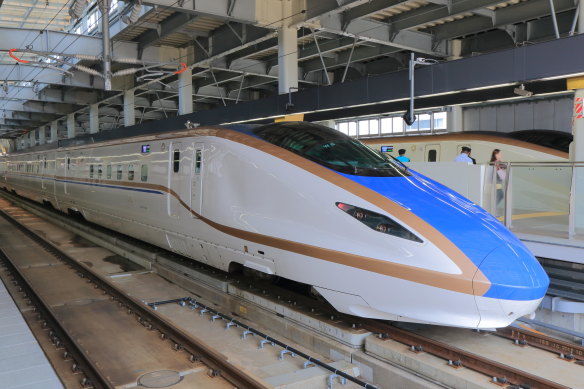Train review: What’s not to love about a Japanese bullet train?
The journey
Tokyo to Joetsumyoko on the JR Hokuriku Shinkansen line, with a scheduled time of two hours and two minutes, aboard the Hakutaka 553, a 12-car, W7 series limited express train.

The Hakutaka Shinkansen.Credit: Alamy
The class
There are three levels of service aboard this Hokuriku line train: super-lux Gran Class, Green Car (or first class), and ordinary class. I’m in ordinary class, which, going by the standards of the rest of the world, is anything but.
Carbon emissions
Ten kilograms per passenger. To fly between these two cities you would have to travel to Osaka, and then Niigata, and then take the train to Joetsumyoko, which would be about 125 kilograms of carbon.
Boarding
By far the hardest thing you will need to do on this journey is get to Tokyo Station and locate the correct platform for your Shinkansen. The Tokyo subway is always busy, and Tokyo Station is labyrinthine and chaotic. Platform signage rotates between Japanese and English, though… slowly. Once you’re in the right spot, you just have to look for signage to see where your particular carriage will pull up, and make sure you’re on time, because the train most definitely will be.
The seat
Seats in ordinary class are arranged in a 2-3 formation, and while they’re a little narrow for those of us with broad shoulders, there’s ample legroom, and a good-sized table that flips down from the seat in front. Power sockets are available for all seats, and there’s free Wi-Fi.
Baggage
Though this used to be a free-for-all, Shinkansen passengers are now allowed a maximum of two pieces of baggage. For each bag the total length, width and height must not exceed 250 centimetres, length must not exceed 2 metres, and weight must not exceed 30kg. Luggage measuring from 160-250cm total (say, a pair of skis or snowboard) requires prior reservation in an oversize luggage seat, at no extra cost.
Food + drink
As with almost all fast train services in Japan, there’s no restaurant car aboard the Hakutaka, just a trolley service selling basic snacks and drinks. If you know Japan though, you know there’s always good food to be had, and in this case, it’s sold at the many eki-ben stands at Tokyo Station. These bento box specialists pedal a dizzying array of pre-packed delicacies – I’ve opted for a gyudon, or stir-fried wagyu beef over rice, with a few pickled vegetables on the side, and an icy cold Sapporo beer, just because I can.
One more thing…
If you’re wondering why I’m travelling to Joetsumyoko, the answer is simple: this is premier ski country, in the heart of the Myoko Kogen, a group of nine ski resorts in the Niigata prefecture. Take the train for two hours from Tokyo, drive a few extra minutes, and you’re up to your armpits in “Jap-pow”.
The verdict
What’s not to love about a Japanese Shinkansen ride? Particularly one that whisks you up into the snow-covered mountains of Nagano and Niigata. The scenery is spectacular, the carriage warm and comfortable, the food top-notch, and the arrival – in a not-exactly-shocking turn of events – is bang on time.
Our rating out of five
★★★★½
The writer travelled as a guest of the Niigata Prefecture Tourism Association. See enjoyniigata.com
Sign up for the Traveller newsletter
The latest travel news, tips and inspiration delivered to your inbox. Sign up now.